Introduction
Worldwide agricultural productivity has increased in recent years in parallel with population growth. The horticultural subsector has grown the most, especially in medium- and high-income countries (28). Pesticides have been one of the external agricultural supplies that have guaranteed increased food production by preventing and controlling various pests that affect crops (32). In recent years, the trend in the use and development of pesticides has undergone modifications. Chemical substances such as organochlorine, organophosphorus, carbamates, and synthetic pyrethroid are being replaced by products with novel action mechanisms and unique chemical structures to avoid emerging pesticide resistance (33) and with apparent lower danger to public health and the environment. Pesticides are associated with this process, mainly in crops of high economic value, protecting investment. Among these crops, tomato is considered one of the most important internationally. Until 2017, China, India, Turkey, the United States, and Egypt centralized production; while Mexico ranked ninth worldwide (9). Until 2020, 54.4% of tomato production in the Mexican Republic was concentrated in the states of Sinaloa (22.9%), Michoacán (11.7%), Zacatecas (6.8%), San Luis Potosí (6.6%) and Baja California Sur (6.4%). In that same year, the State of Oaxaca was in seventeenth place (1.7%), where the Valles Centrales region led the production (49.9%), followed by Huajuapan de León (15.1%), Istmo (14.5%), Cañada (14.4%) and Sierra Juárez (6.2%). Greenhouse production reached 62.9%, compared to open field (37.1%) (29).
Tomato crops are susceptible to various arthropod insects and a wide variety of diseases caused by multiple pathogens (fungi, viruses, and bacteria) in the various phenological phases of growth (pre-harvest and post-harvest), as well as in different parts of the plant (root, stems, foliage and fruits) (16). These insects and pathogens cause considerable decrease in yield and consequent high economic losses. Chemical control using pesticides turns normal.
In recent years, tomato cultivation has increased in various municipalities of the State of Oaxaca, particularly in the Valles Centrales region. Currently, for this region, there is limited information on pathogen diversity or pesticide usage. Specifically, for San Baltazar Chichicapam, mites, blight, and powdery mildew have been reported and controlled with abamectin, bifenthrin and mancozeb (26). National reports for various vegetables evidence indiscriminate use of pesticides of different types (herbicides, insecticides, and fungicides) belonging to different toxicological categories and chemical groups (organophosphates, carbamates, dithiocarbamates, pyrethroids, bipyridyls, and even organochlorines) (10,24). Therefore, it can be assumed that tomato production systems located in said region, not yet documented, represent a scenario where farmers might be highly exposed to pesticides of different toxicity. Considering the information cited, the present study documents the presence of pests and diseases on tomato crops, the diversity of pesticides used, and the symptoms related to acute intoxication due to pesticide exposure, in different regions of the State of Oaxaca.
Materials and methods
A descriptive study was carried out in municipalities from different regions of the State of Oaxaca from September 2019 to September 2021 (Figure 1).
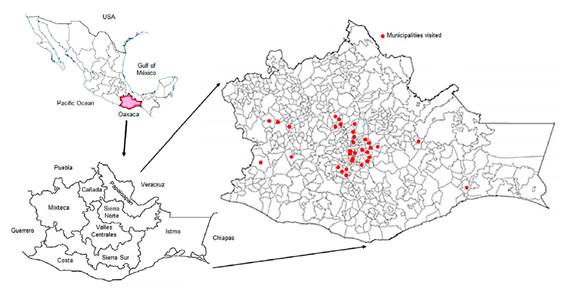
Figure 1 Study locations in the State of Oaxaca. Figura 1. Ubicación del área de estudio en el estado de Oaxaca
The study population included tomato producers residing in the visited sites. Several field visits identified producers who, by prior authorization and manifesting pesticide use, completed a survey documenting age and information related to tomato cultivation (historical time of the crop; pest and disease problems; and pesticide use), as well as APP symptoms during or after fumigation (2,11,12). All individuals were informed of the study’s objective under the Helsinki Declaration with the approval of the Institution’s Ethics Committee.
Information based on producers knowledge, allowed characterization of the insects and diseases, i.e., no biological collections were taken. Revision of technical safety sheets based on trade names determined active ingredients, chemical classification, and type of action (herbicide, insecticide, or fungicide). The toxicological category (TC) was based on the Federal Commission for the Protection against Sanitary Risks (COFEPRIS, by its acronym in Spanish) (5), substantiated by the LD50 expressed in mg/kg recommended by the World Health Organization (WHO), and under the Official Mexican Standard: NOM-232-SSA1-2009 (19).
Statistics included frequencies for the qualitative variables and measures of central tendency and dispersion for quantitative variables. The Student’s t or Mann-Whitney U test and Pearson’s or Spearman’s Rho correlations were used, respectively, following normality of data according to Shapiro-Wilk test for comparison among groups (19 to 50 / >50 years, <1.0 / >1 ha cultivated, <10 / >10 years of seniority in the activity) and the number of AI used, and to relate the number of AI used with the number of APP symptoms and number of pests and diseases. The statistical package used was SPPS v.15.0.
Results
The sample size was 114 producers: 61.4% were from 26 municipalities in the Valles Centrales region, 15.8% from four Mixteca municipalities, 10.5% from the Sierra Sur, 10.5% from the Istmo, and 1.8% in two towns in the Sierra Norte. The average age was 43.8±14.1 years (range =19 to 73 years). The predominance age group was 19 to 50-year-old group (68.9%) followed by the >50-year-old group (31.1%). The average area cultivated with tomatoes was 1.2±1.4 ha, with areas <1.0 ha (73.5%) outweighing areas between 1.0 and 5.0 ha (26.5%). The average tomato cultivation period was 8.8±7.4 years, predominantly producers with <10 years growing tomatoes without performing crop rotation (78.1%) over producers between 11 and 34 years old in the same activity (21.9%). According to the farmers’ perspective, the most common problem is pest and disease attack (92.1%), followed by economic difficulties (31.6%), lack of training and technical advice (28.9%), droughts (26.3%), poor quality of irrigation water (13.2%), low soil fertility (9.6%), floods (3.5%), and excessive winds (0.9%). The average attack by insects was 2.5±2.6 of 10 different problems, mainly white flies and various worms, while for disease development, the media was 2.2±2.3 of 8 identified diseases, mainly blight and mildew. A proportion of 38.6% of the producers stated that weeds must be controlled to guarantee crop production (Figure 2).
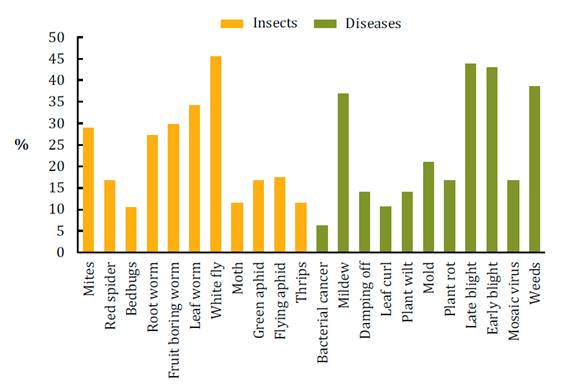
Figure 2 Pests and diseases affecting tomato crops. Figura 2. Plagas y enfermedades que afectan al cultivo de tomate
The average was 5.1±3.2 different types of pests and diseases out of 19 identified; 64% stated up to five, 28.1% from six to ten, and 6.1% from 11 to 18.
A total of 55 active ingredients (AI) from 92 commercial pesticides were identified, corresponding to 35 chemical groups. TC IV products predominate, followed by TC V, III, II, and I. According to their action, insecticides predominate, followed by fungicides, herbicides, and bactericides. In general, the use of TC IV insecticides and fungicides and TC III herbicides prevails (Table 1, page 36).
Table 1 Toxicological category of identified pesticides via active ingredients (AI) and commercial presentation (CP). Tabla 1. Categoría toxicológica de los plaguicidas identificados en el presente estudio, a través de sus ingredientes activos (IA) y presentación comercial (PC).
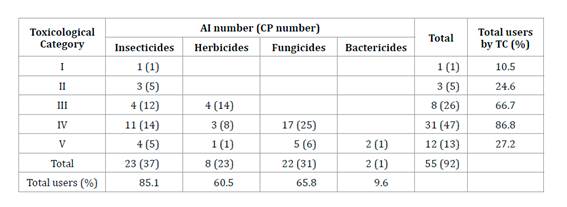
When detection and identification of more pests and diseases occurred, more varieties of AI were used (Spearman’s Rho=0.202, p=0.031). In addition, there was a significant increase in AI use on surfaces over 1 ha, compared to smaller áreas (Mann-Whitney U = 437.5, p = 0.014). Producers with <10 years in tomato production, used a significantly greater diversity of AI compared to producers with greater seniority (Mann-Whitney U= 710.5, p=0.005). No significant differences were identified between age groups and number of AI used. The most frequently used insecticides were the combination of lamba-cyhalothrin with imidacloprid by the commercial brand Corax (pyrethroid and neonicotinoid TC III), imidacloprid by Confidor and Patron, methomyl by Lannate and generic methomyl (carbamate TC II). A small group of users utilized methyl parathion as Foley (organophosphate TC I). The most used fungicides were Captan by the same trade name (carboxamide, TC IV), followed by mancozeb by Manzate brand (dithiocarbamate, TC IV), metalaxyl by Ridomil mainly (anilide, TC IV), and the combination of metalaxyl with mancozeb by Ridomil Gold. For herbicides, glyphosate (phosphonate TC IV) and paraquat (bipyridyl TC III) stand out under various commercial brands. The bactericides identified were streptomycin in combination with oxytetracycline under the trade name Agri-mycin 100, used by a small group (Table 2, pages 37, 38 and 39).
Table 2 Classification of identified pesticides in tomato crops. Tabla 2. Clasificación de los plaguicidas identificados en el cultivo de tomate

H / I / F / B: Herbicide/Insecticide/Fungicide/Bactericide. b TC: Toxicological Category: I (extremely dangerous), II (highly dangerous), III (moderately dangerous), IV (slightly dangerous), and V (normally not dangerous) (5, 19). c Criteria for inclusion in the PAN International Highly Hazardous Pesticides list: [1] High Acute Toxicity; [2] Chronic effects on human health; [3] Environmental toxicity; and [4] Restricted or prohibited by environmental conventions (21). d PAN International list of prohibited pesticides in other countries (22). e Use restricted by COFEPRIS (2022).
a H / I / F / B: Herbicida/Insecticida/Fungicida/Bactericida. b CT: Categoría Toxicológica: I (extremadamente peligroso), II (altamente peligroso), III (moderadamente peligroso), IV (ligeramente peligroso), V (normalmente no peligroso) (5, 19). c Criterios de inclusión en la lista de Plaguicidas Altamente Peligrosos de PAN Internacional: [1] Toxicidad Aguda alta; [2] Efectos crónicos en la salud humana; [3] Toxicidad ambiental y; [4] Restringidos o prohibidos por convenios ambientales (21). d Lista de plaguicidas prohibidos en otros países de PAN Internacional (22). e Uso restringido por COFEPRIS (2022).
An average of 3.9±2.3 AI per producer is used, 48.2% use up to three AI, 32.5% from four to six AI, and 19.3% from seven to nine AI.
Plot average fumigation time was 2.8±1.8 hours daily. Producers (31.6%) stated having at least one hour a day exposure, 36.8% up to three hours, and 31.6% up to six hours. A high diversity of fungicides and insecticides control different diseases and insects. Triazoles are chosen as fungicides, and pyrethroids, organophosphates, neonicotinoids, and carbamates, as insecticides. Several producers (7.9%) used duplicated applications of the same active ingredient via different commercial products, especially three herbicides (Paraquat: Gramoxone and generic Paraquat [0.9%], Gramoxone and Matatodo [0.9%]; 2, 4-D: Amina and Herbidex [0.9%]; Glyphosate: Diablozate with Rival [0.9%], Faena and Colossus [0.9%]; Faena with Secafin [2.6%]) and an insecticide (Ciantraniliprol: Benevia and Verimarck [1.8%]). In addition, a group of producers applied some pesticide mixed with foliar fertilizers (17.5%) or other pesticides (7.9%). Three users combined insecticides (Arrivo with Karate: cypermethrin with lamda-cyhalothrin; Foley with Engeo: parathion with thiamethoxan+lambda-cyhalothrin; Patron with Lannate: chlorpyrifos ethyl with methomyl), three users mixed herbicides (Herbipol with Coloso: 2,4-D with glyphosate; Tordon 101 with Tordon 472: both contain picloram+2,4-D; Diablozate with Tordon 101: glyphosate with picloram+2,4-D), one user mixed fungicides (Cymoxanil with Manzate: cymoxanil with mancozeb), and two users used insecticides with fungicides (Foley -paration- with fungicides without mentioning their names; Karate with Cymoxanil and Manzate: lamda-cyhalotrina, cymoxanil, and mancozeb).
The average number of APP symptoms in producers was 3.0±2.6 out of 17 identified. While 36.0% manifested up to three symptoms, 24.6% had four to six symptoms, and 12.3% from seven to ten symptoms. The symptoms most frequently perceived were headache, burning skin, dizziness, itching, muscle and stomach pain, and watery eyes, in that order of occurrence (Figure 3, page 40).
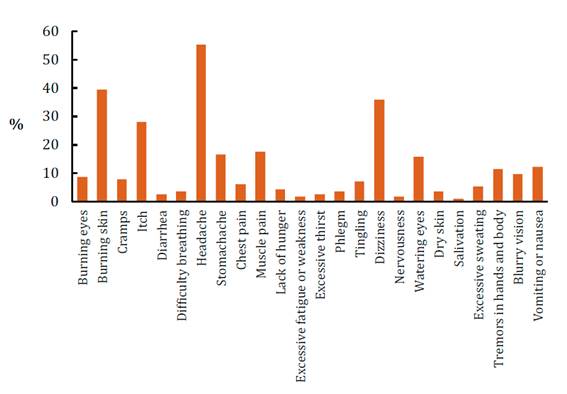
Figure 3 Symptoms of acute pesticide poisoning perceived by users. Figura 3. Síntomas de intoxicación aguda por plaguicidas percibidas por los usuarios
The average time for the symptoms to appear was 5.0±4.5 years, during and after fumigation. No producer mentioned using personal protection when fumigating. No significant association was identified between the number of AI and APP symptoms (Spearman’s Rho=0.066, p=0.488). It should be noted that 27.2% of the users stated no symptoms.
However, 60% of the users accepted that some pesticides used, cause said symptoms, insecticides predominating and particularly, imidacloprid in combination with betacyfluthrin, followed by the herbicides paraquat, picloram+2, 4-D, methamidophos, methomyl, and glyphosate mainly (Figure 4a, page 41).
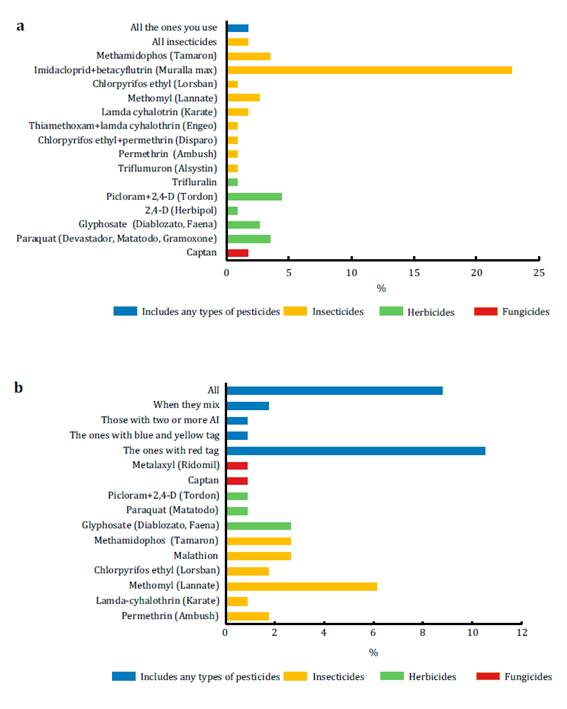
Figure 4 a- Active ingredients perceived as responsible for APP symptoms, and b- Active ingredients identified as the most dangerous. Figura 4. a- Ingredientes activos percibidos como los responsables de los síntomas de IAP y, b- Ingredientes activos identificados como los más peligrosos por los usuarios
A small group of users stated all insecticides and/or pesticides used, cause their perceived symptoms. In addition, 44.7% of the producers affirmed that red-labeled products and insecticide and herbicide types are the most dangerous and toxic, with methomyl and glyphosate predominating in the latter groups, respectively (Figure 4b, page 41). Nine users (7.9%) agreed that the same AI responsible for APP are the most dangerous and toxic. The products were permethrin (Ambush), glyphosate (Diablozato and Faena), lamda-cyhalothrin (Karate), methomyl (Lannate), chlorpyrifos ethyl (Lorsban), and methamidophos (Tamaron), mainly belonging to neonicotinoids, pyrethroids, bipyridyl, organophosphates, and carbamates.
Discussion
Tomatoes are one highly demanded vegetable in the Mexican national market, and the State of Oaxaca is no exception. This high demand for tomatoes is explained by the need to be met in the Valles Centrales region, which is home to 33% of the state population in 121 municipalities, and in particular, in the metropolitan area, where 17.7% of the total population resides, and distributed in 23 municipalities. The identification of a significant number of young producers in the Valles Centrales region coincides with this increased demand for tomato production (29). The increased economic opportunity is attractive for new producers. However, farmers face various problems, some of which coincide with what has been reported in other studies, where climate change, pests, and diseases negatively affect vegetable productivity, including tomatoes, worldwide (15). In particular, early blight and powdery mildew cause the most damage in the South of Tamaulipas (27) and Sinaloa, Mexico (8). Insects, such as white flies and various worms cause severe damage in multiple provinces of Ecuador (4) and in the Ivory Coast, Africa (31). This reaffirms that tomatoes are susceptible to a variety of insects and diseases (25), that if not prevented and/or controlled, cause substantial yield losses and severe economic impacts.
The present study identified a significant association between using high diversity AI against a greater number of pests and diseases, in areas >1 ha, and producers with <10 years of experience. These findings are similar to those reported for Los Altos de Chiapas, Mexico (1), where increased pesticide use was found in the largest agricultural áreas with the highest diversity of pests and diseases. Recently incorporated producers use a greater variety of AI to obtain the highest possible agricultural yields and guarantee investment returns, coinciding with what was reported for Loja, Ecuador (3). These facts indicate similarities in the circulation and use of various AI in Mexico and South America. In addition, there is evident abuse in the application of various pesticides individually and in mixtures, as occurs in other similar production systems in India (13) and Ghana (6). Concerning mixtures, underreporting of pesticide application is likely due to fear of sharing which mixtures they consider more successful in preventing or controlling pests and diseases. It is essential to mention that several non-COFEPRIS (2022), recorded insecticides were identified (Glextrin 25, Casta, Estrella, and Alsystin), probably because they are not yet registered or being sold clandestinely in the state.
It is alarming that 58.2% of the AI identified are considered Highly Hazardous Pesticides, fungicides, and herbicides due to their chronic effects on human health, while most commonly used insecticides in this group are included in the list mainly because of their environmental toxicity. In addition, 67.3% of AI are prohibited in other countries due to their high acute and environmental toxicity including possible chronic health effects (21,22). However, the fungicide chlorothalonil, the insecticide methamidophos, and the herbicide paraquat are considered restricted pesticides in Mexico by COFEPRIS (2022) and a recent campaign promotes the gradual elimination of glyphosate by a presidential decree published on December 31, 2020 (7). Unfortunately, in the agricultural fields of the Mexican southeast, this chemical is still being used.
Regarding APP symptoms, 27.2% of producers stated not having any. However, it is likely they hide their symptoms, since it is common among the rural male population to project they are strong and perceive themselves as immune to the dangers that APP represents (14). Several identified APP symptoms are reported when users are exposed to acetylcholinesterase inhibitors (muscarinic and nicotinic), such as carbamates and organophosphates (34). Health damage from exposure via inhalation during fumigation is exhibited mainly through symptoms related to the central nervous system. Dermal exposure damage is seen by skin irritation given absent personal protection while fumigating. The presence of weakness, headache, dizziness, fever, and skin irritation have been reported with the use of pyrethroids and carbamates mainly in small tomato producers in Cameroon (30), as well as in Arusha, Northern Tanzania (17), similar to the findings obtained in this study.
A considerable proportion of producers have shown three or more APP symptoms. Although no clinical tests were used to detect residues or metabolites of the identified pesticides, one or several pesticides used are possibly responsible for their symptoms. The high variety of commercial products applied individually or mixed complicates AI accurate identification concerning APP symptoms. Even though most of the AI used belong to fungicides and insecticides of TC IV and V, considered by Mexican regulations as only dangerous and not harmful, they still harm human health and the environment causing potential latent health risk among producers chronically exposed to these pesticides, as well as health risks to consumers, since residual pesticide contamination in food has been documented. Such is the case for the presence of pyrethroid insecticides lambda-cyhalothrin, cypermethrin, and deltamethrin, as well as the organophosphate chlorpyrifos on tomato surfaces (20). In this regard, acute poisoning due to intake of contaminated food is not frequent. However, daily consumption may lead to diseases manifesting in the long term, such as various types of cancers (18), implying a public health problem.
Despite the limitation of the sample size, this study provides information for governmental and non-governmental agencies in the agricultural sector to propose actions addressing this problem. For example, proper training in the use and management of pesticides is highly recommended. In addition, personal protection during pesticide application is strongly recommended. It is also advisable to carry out periodic phytosanitary diagnoses, establishing better control techniques, along with gradual replacement of pesticides with more environmentally friendly products. Taking this a step further, promoting agroecological practices (like crop rotation, use of plant extracts and allelopathic plants, among others) (23), guarantees healthier plants, and promotes a safer work environment and more nutritious food for the consumer. Pesticide-residue monitoring in the harvested product, water, and soil, as well as in users and consumers, helps identify possible risks to public health and the environment.
Conclusions
Younger producers are introducing themselves to tomato cultivation under a conventional system with the intensive use of various pesticides, predominantly TC IV insecticides and fungicides, as well as TC III herbicides. Primary damages to tomato crops are due to white flies, multiple worms, blight, mildew, and weeds. In the short period of conventional agriculture, increasing pests and diseases in areas >1 ha is associated with using a greater variety of pesticides. Most producers had up to six APP symptoms, related to organophosphates and carbamates, and predominantly to the central nervous system and skin. However, the possibility that several symptoms are related to other chemical groups has not been ruled out. Pesticide use will likely continue in the area studied, thus, in the medium to long term, health damages associated with acute and chronic exposure to the pesticides identified will continue. We recommend promoting the adoption of agroecological practices, providing training in the proper use and management of pesticides, and gradual substitution with less aggressive products.














